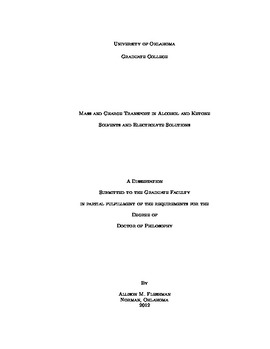| dc.contributor.advisor | Yip, Wai Tak | |
| dc.contributor.author | Fleshman, Allison M. | |
| dc.date.accessioned | 2014-03-24T22:05:05Z | |
| dc.date.available | 2014-03-24T22:05:05Z | |
| dc.date.issued | 2012 | |
| dc.identifier.uri | https://hdl.handle.net/11244/8106 | |
| dc.description.abstract | Experimental data show there is a distinct relationship between the molal conductivity and concentration for electrolyte solutions with low dielectric constants. The molal conductivity decreases with the square root of the concentration to a minimum in the area referred to as "region I", and then increases to a maximum over the concentration range referred to as "region II". This behavior has been attributed to changes in ionic association in the electrolyte. The electrolyte systems used in this study, however, show this behavior but exhibit no spectroscopic evidence of ionic association. Molecular level properties are determined using the compensated Arrhenius Formalism (CAF) that add valuable insight in describing the qualitative behavior of the molal conductivity with concentration. The CAF assumes that transport is a thermally activated process, and uses the dielectric constant as a measure of changes in the intermolecular interactions. This formalism makes it possible to measure the energy of activation for mass and charge transport. Hydrodynamic models that use the solution viscosity as a characteristic system property in describing transport do not paint any picture of these transport mechanisms at the molecular level. Modeling mass and charge transport as a thermally activated process through the use of the CAF agrees with the experimental data. This work uses the dielectric constant as a key component in describing transport. The CAF is applied to mass transport in hydrogen-bonded 1- and 3-alcohol liquids and non-associating 2-ketone liquids, and the differences observed between the systems are explained using the CAF results. The CAF is also applied to a range of concentrations of tetrabutylammonium trifluoromethanesulfonate (TbaTf) dissolved in 1- and 3-alcohol and 2-ketone solvents. The results offer a new interpretation for the qualitative behavior of the molal conductivity with concentration. This work will show that the increase in region II is a complicated relationship between the concentration dependence of the energy of activation and the concentration dependence of the dielectric constant, consistent with the data from multiple electrolyte systems. | en_US |
| dc.language | en_US | en_US |
| dc.subject | Chemistry, Physical. | en_US |
| dc.title | Mass and charge transport in alcohol and ketone solvents and electrolyte solutions | en_US |
| dc.contributor.committeeMember | Glatzhofer, Daniel T. | |
| dc.contributor.committeeMember | Rice, Charles | |
| dc.contributor.committeeMember | Moore-Furneaux, John | |
| dc.contributor.committeeMember | Wheeler, Ralph A. | |
| dc.contributor.committeeMember | Frech, Roger | |
| dc.date.manuscript | 2012 | |
| dc.thesis.degree | Ph.D. | en_US |
| ou.group | College of Arts and Sciences::Department of Chemistry and Biochemistry | |
